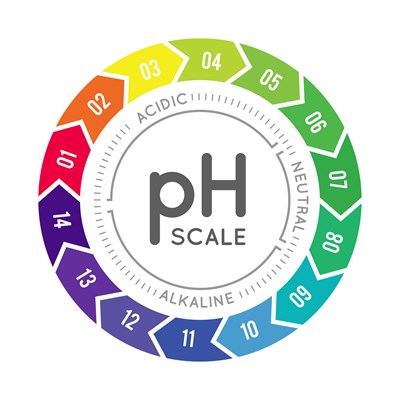pH is a measurement of the power of hydrogen (hence “pH”) or H+ ions. pH is measured on a 0 (extremely acid – pure Hydrochloric acid) to 14 (extremely alkaline – pure sodium hydroxide) scale, with 7 (the concentration of H+ ions at room temperature in pure water) being neutral. Both extremes are damaging to all plants, which generally prefer values between 6 and 7. pH is expressed on a base 10 logarithmic (log) scale, which means there is a ten-fold difference between numbers. That means 4 is 10 times more acidic than 5, 100 times more acidic than 6 and 1,000 times more than 7.
On clay loams and lighter sandy loams, sugar beet typically grows best at pH 7.0. On lower pH soils as peats and organic soils, the optimum is between pH 6 and 6.5. However, sugar beet is sensitive to low pH and historically it has been considered one of the major causes of poor performance. Patches of small stunted pale plants with poorly developed and stubby roots are all indicators of acid conditions.
Early trials data showed that between pH 7 and pH 6, reductions in top and root growth of 10-25% and 15% sugar yield could be expected (Ulrich & Ohki, 1956, McEnroe & Coulter, 1964). Whilst improved soil management, agronomy and the use of lime (about 25% of land is limed ahead of sugar beet) have all been deployed to reduce soil acidification, are there indications that current yields may be still held back by low pH ?
There is data that suggests this is the case:
During the 2017 BYC season, of the thirty crops that were monitored, the range of soil pH was between 6 and 8.5 However, these were the overall field average. More detailed within-field sampling showed that 46% of fields had areas of pH below 6.5 and 20% with patches below pH 6. At these pH levels, there are potential yield effects.
When the relationship between pH and yield was plotted on a graph, the corresponding yields at pH 6 and 7 were as below, confirming that indeed, there was an effect of pH on yield. A loss of more than 10%.
|
pH |
Yield (t/ha) |
|
|
6.0 |
80 |
|
|
7.0 |
89 |
+11.2% |
|
8.0 |
92 |
|
An important reminder for us from the BYC data is also of the need to sample in detail for pH. It is risky to rely on a composite soil sample for pH as few soils are truly uniform for pH. In fact, in one of the BYC fields, the pH varied from 5.4 to 7.5. Ensuring that we can measure the extent of the variation, allowing us to lime at the right level for the field is important.
One of the biggest impacts of pH is on nutrient availability. There are complex relationships between elements such as aluminium and manganese, pH and plant growth but also key elements such as phosphorous which can be limiting at a pH below 6.5 soils, especially early in the season when soil is still wet and cool.
Whilst the main effect of pH may be on nutrient availability, certain disease, especially seedling blackleg symptoms due to fungi such as Aphanomyces and Pythium can also be affected by pH. It is generally accepted that acid soils favour the development of these diseases.
And, more recently, studies such as the Soil Biology & Soil Health Partnership (jointly sponsored by BBRO & ADHD) have shown that the biological activity of the soil is reduced in more acid soils. On-going studies measuring biological activity, as indicated by the number of earthworms and measures of soil microbial biomass support this.
So, soil pH is possibly sometimes overlooked as a cause of poor yield performance but clearly, it remains a factor in our current crops. It is certainly an agronomy basic and in our opinion, its correct measurement and management remains an important key to unlocking yield potential.




